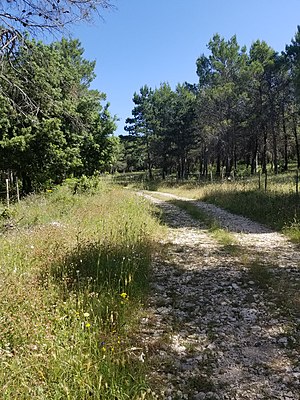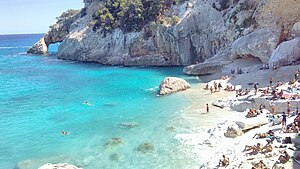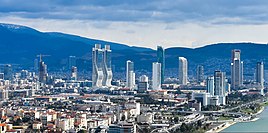Castra Osaniovo
This article is a work-in-progress because it is incomplete and pending further input from an author. Note: The contents of this article are not considered canonical and may be inaccurate. Please comment on this article's talk page to share your input, comments and questions. |
Castra Osaniovo | |
|---|---|
Capital of Narico Province | |
City Hall The Arch of Nerenzio The cityscape of downtown Corso Vittorio Lotus II at night Meridionali Resonare (Southern Echo Resort & Spa) | |
| Nickname(s): Los Aquilonare (The Northern Coast) | |
| Country | Caphiria |
| Province | Narico |
| Townships | 16 |
| Government | |
| • City Prefect | Vadar Rahaleos (Loyalist Union) |
Castra Osaniovo is a metropolitan city on the southern coast Caphirian Urlazio, across the Urlazian Sea. It is the capital city of the Caphirian province Narico. It has nearly 800,000 citizens, while its metropolitan area (including Castra Osaniovo and 15 other municipalities) has more than 1,722,000 inhabitants. The city is noted for its history, culture, and architecture. Its natural resources have always been its sheltered harbour, the often powerfully fortified hill of Trynn, the salt from its lagoons, and, from the hinterland, wheat from the Pohella plain and silver and other ores from the Naseph mines.
Castra Osaniovo has over 3,000 years of recorded urban history, having been a human settlement since the Adonerii civilization in the 4th century BC. Under the modern city lies the ruins of the Old Castrum, a medieval fortification built during the 16th century. The city's role as a major political centre dates back to the end of the Second Imperium when Caphiria was under constant attack from Muslim raids. From the 10th century until the 13th century, the city was a coveted defensive port, one of the most important in Sarpic history. As the Third Imperium reached its peak during the late-15th to 16th centuries, Castra Osaniovo became a major trade and commercial hub as it connected Levantia to Sarpedon. Despite losing much of its political and cultural importance during the First Great War, the city regained its status as a major economic and political center.
Today, the city is known for its strong presence in the art, chemicals, commerce, design, education, entertainment, fashion, finance, healthcare, media (communication), services, research and tourism sectors. Castra Osaniovo is a regional cultural, educational, political and artistic centre, known for its diverse Relerio Nouveau architecture. It is also the province's economic and industrial hub, having one of the biggest ports in the Urlazian Sea, an international airport, and one of the highest income levels in the Imperium. Over the last 50 years, tourism in Castra Osaniovo has quadrupled. This is due to the many beaches becoming a popular destination for weddings and honeymoons, student vacations and an influx of celebrities moving to live in the area. The tourism and entertainment business flourishes here unlike in any other city so much so that many have nicknamed Castra Osaniovo to Novas Venciea.
Geography

The city of Castra Osaniovo is situated in the south of Narico, overlooking the center of the eponymous gulf, also called sinus angelicus ("Bay of Angels") after an ancient legend. The city is spread over and around the hill of the historic district of Castello and nine other limestone hills of the middle-to-late Miocene, unique heights of a little more than 100 metres (330 ft) above sea level on the long plains of Khesa.
The repeated intrusion of the sea left calcareous sediments that formed a series of hills that mark the territory of Castra Osaniovo. That is where a fortified town arose near the harbour of the port, the birthplace of the city, as well as Mount Divereo, the New Point hill, also known as the Sella del Diavolo ("Saddle of the Devil") for its shape, Kingshill and Marblerock, the site of the ancient Sarpic and Caphiric necropolis, the small Boria hill, where the basilica stands, and the San Mirolt hill, with the eponymous castle on top.
The modern city occupies the flat spaces between the hills and the sea to the south and southeast, along the Nysah beach, the lagoons and ponds of Cocoa Cove and Blaurano, and the remains of more recent marine intrusions, in an articulate landscape with many landmarks and panoramas of the bay, the plain, and the mountains that surround it on the east (The Seven Brothers and Serpeddì) and west (the mountains of Ursina).
The city has 6 historic neighbourhoods: Santonia, Geaneos, Ariaca, Seoria, Rurres, and Montiranara. There are also several modern districts, grown when part of the ancient walls had been demolished in the middle of the 19th century, such as Martore, Krussov, and Goldrun at the east, Saint Amberholde at the west, Falerii Vale to the north and Caere, La Lentia, and Emona at the south.
Parks

Castra Osaniovo is one of the "greenest" Caphirian cities. Every inhabitant of Castra Osaniovo has access to 87.5 square metres (942 sq ft) of public gardens and parks. Its mild climate allows the growth of numerous subtropical plants, such as the Greater Island Pine, Virgin's Winter Willow, Queen White-Root, White Roundleaf Corydalis, Tassel Dogbane and Perennial Violets.
Major parks include:
- Pandora Meadows, which extends for about 25 hectares
- Crescent Park, which extends for about 20 hectares), with its medieval castle on the top
- Almond Gardens, which extends for about 13 hectares, with a little pond which is home to flamingos and other wading birds
- Grand Avenue Park, which extends for about 22 hectares, which hosts the city library in an old mansion on the top of the hill
- Trillium Plaza, which extends for about 2.5 hectares
The Naricon Provincial Park is located near the city. Some mountain parks, such as White Stag or Ocro, with large forests and wildlife (deer, wild boars, etc.) are also nearby.
Beaches

The main beach of Castra Osaniovo is the Sacard. It stretches for about 8 kilometres (5 mi), from Sella del Diavolo ("Devil's Saddle") up to the coastline of Quartu Sant'Elena. Sacard is also the name of the district located on the western stretch of the strip between the beach and Saline di Tupoh ("Tupoh's Salt Mine").
Another smaller beach is that of Paemon near the Sant'Elia district. On the coast between the Paemon and Sacard beaches, among the cliffs of the Sella del Diavolo, lies Mirror Bay.
Castra Osaniovo is close to other seaside locations such as Jericho Shore, Gans Harbor, Kingshill Piers, Braubach, Cacourt and Canau.
Climate

Castra Osaniovo has a Mediterranean climate with hot, dry summers and very mild winters. The summer extreme values can be slightly over 40 °C (104 °F), sometimes with very high humidity, while in winter, under special and rare conditions, the temperature drops slightly below zero. Heavy snowfalls occur on average every thirty years.
The average temperature of the coldest month, January, is about 10 °C (50 °F), and of the warmest month, August, about 25 °C (77 °F). But heat waves can occur, due to Urcean anticyclone, starting in June. From mid-June to mid-September, rain is a rare event, limited to brief afternoon storms. The rainy season starts in September, and the first cold days come in December.
Winds are frequent, especially the mistral and sirocco; in summer, a marine sirocco breeze lowers the temperature and brings some relief from the heat.
Politics
Castra Osaniovo is the seat of the Superintendency of Cultural and Environmental Heritage, of the Naricon Archival Superintendency, of the Archeological Superintendency of the Cultural Heritage Ministry, of the provincial seat of the Employment and Social Policies Ministry, of the regional offices of the Finance and Economy Ministry, and of some branch offices of the Health Ministry.
Castra Osaniovo is home to all criminal, civil, administrative, and accounting courts for Narico from the Ministry of Justice up to the High Court of Assizes of Appeal. It is home to a prison, Sailasch, built in the late 18th century, famous because no one has ever managed to escape. A new modern prison is under construction in the nearby town of Usati.
Economy
According to 2030 data from the Ministry of Economic Affairs, the inhabitants of Castra Osaniovo returned an individual income tax per capita that was 128% of the national average, while all of Narico returned only 80%. The metropolitan area returned 97% of the national average. As usual, the urban area income is greater than that of boroughs or countryside, but considering all of Narico the figure is particularly significant.
The first department store - La Rinascente - opened in 1900 in the centre of the city, and it is still open today. Nowadays there are many commercial centres in the metropolitan area (Le Vele, Santa Gilla, La Corte del Sole, Marconi) hosting many luxury department stores.
The Vocrard-Elzuzad area between Castra Osaniovo and Ad Novas is one of the most important industrial areas of Castra Osaniovo, in conjunction with a large international container terminal port at Abral. Besides having one of the biggest container terminals in the Urlazian Sea, Castra Osaniovo also has one of the largest fish markets in Caphiria offering for sale a vast array of fish to both the public and traders. The Cartadanian communications provider Axiom also has offices in Castra Osaniovo.
Tourism is one of the major industries of the city; although historical venues such as the Arch of Nerenzio draw hundreds of thousands of visitors annually, its Latin ruins are less highlighted compared to the recreational beaches and coastline. Cruise ships touring the Urlazian Sea often stop for passengers at Castra Osaniovo, and the city is a traffic hub to the nearby beaches of Cacourt, Tlesuhl, Braubach and Canau, as well as to the urban beach of Sacard. Braubach is home to the archaeological site ruined city of Noca. Especially in summer, many clubs and pubs are goals for young locals and tourists. Pubs and nightclubs are concentrated in the Corso Vittorio Lotus II, a narrow street in Clove district near the port and in the Caspela district, The clubs are mostly to be found on the Sacard Beach (in summer) or in Viale Cacourt (in winter).
Demographics
According to the latest census, there were 783,622 inhabitants of Castra Osaniovo, 467,263 were male and 316,359 were female. Minors (children aged 18 and younger) totalled 11.62% of the population, compared to pensioners at 26.81%. The average age of Castra Osaniovo residents is 47.44. The ratio of the population over 65 years of age to that under the age of 18, is 53.39%. The elderly population, defined as being over 65 years of age, has increased by 21.95% over the last 10 years. The current birth rate in Castra Osaniovo is 6.29 births per 1,000 inhabitants. The average number of people of any age per household is 2.11 and the percentage of households composed of a single person is 42.53%. The population of Castra Osaniovo is structured like that of other first world countries, especially as to the prevalence of an elderly population. The trend of these rates in the Castra Osaniovo metropolitan area is proportionally reversed in the suburbs, where most younger families move.
As of the most recent census, 8.26% of the population was foreign, of which the largest group were Kiravian (21.33%), followed by Cartadanian (11.93%), Urcean (10.93%), and Pelaxian (6.49%).
Culture
The city has numerous libraries and was also home to the State Archive, containing thousand of handwritten documents from the foundation of the Kingdom of Vetera (1325 AD) to the present. In addition to numerous local and university department libraries, the most important libraries are the old University Library, with thousands of ancient books, the Provincial Library, the Regional Library, and the Mediateca of the Vetera, which contains the municipal archive and library collection.
Life in Castra Osaniovo has been depicted by many writers, starting with the late Caphirian poet Claudian. In the late 16th century, the local humanist Ezio Centrone dedicated to his town a didactic Latin poem, Caralis Panegyricus. At the beginning of the 17th century, Julian De la Cruz wrote a hymn to Castra Osaniovo in Spanish; Aurelius Herrera published in 1636, in Spanish, the first novel set in Castra Osaniovo, entitled El Forastero. Lucio Soto wrote about the city in his Oceans of Castra Osaniovo.
Modern writers connected to Castra Osaniovo include Onorino Menotti, Gloria Todisco, Lea Pagni, and Fiordaliso D'Urso, who set many of his novels and short stories, such as Banin's Son, in ancient and modern Castra Osaniovo.
Castra Osaniovo was the birthplace or residence of the composer Aldo De Stefanis, of the film, theatre and TV director Arion Pernaska, and of the actors Dalin Varoshi, Basim Daas and Cole Lias (born Napoleon Vlahakis).
Excluding the republic era amphitheater, the first theater was inaugurated in Castra Osaniovo in 1767: the Teatro Zapata, later becoming the Civic Theatre. Devastated by bombing in 1943, it was recently restored, but the roof was not rebuilt, and today it serves as an open-air theatre. The Politeama Regina Margherita, inaugurated in 1859, was destroyed by fire in 1942 and never rebuilt.
Education
Castra Osaniovo is home to the University of Castra Osaniovo. It currently includes six faculties: Engineering and Architecture, Medicine and Surgery, Economics, Juridical and Political Sciences, Basic Sciences, Biology and Pharmacy, Humanistic Studies.
It is attended by about 35,000 students. All science faculties of the university, as well as the university hospital, have been transferred to a new "University Citadel", located in Cariati. Castra Osaniovo downtown houses the engineering and the humanities divisions and, in the Castle, the seat of the Rector, in an 18th-century palace with a library of thousands of ancient books.
Castra Osaniovo is also the seat of the Pontifical Faculty of Theology of Narico and of the Caphirian Institute of Design.
Healthcare
There has been a public hospital in Castra Osaniovo since the 17th century. The first modern structure was built in the middle of the 19th century, designed by the architect Gaetano Cima. This hospital is still operating, although all its departments will eventually be transferred to the new University Hospital in Cariati.
Among the other public hospitals, the Hopevale Medical Center was recognized in 1993 as a High Specialization Nationally Relevant Hospital, particularly for liver, heart, pancreas and bone marrow transplants.
Other public hospitals in the city include: the Santissima Trinità or commonly Is Mirrionis; the Binaghi, specialised in pulmonology; Marino specialised in traumatology, hyperbaric medicine and spinal cord injuries; Businco specialised in oncology; and Microcitemico, specialised in thalassemia, Genetic diseases and rare diseases. There are in addition many private hospitals.
Despite its dry climate, thanks to the regional system of dams, every inhabitant of Castra Osaniovo may have 363 litres (96 US gal) per day of safe drinking water. Waste sorting is still at a low level: only 33.4 percent of waste is separated.
Transportation
The city is served by the Lucenta International Airport, located a few kilometres from the centre of Castra Osaniovo. A railway line connects the city to the airport; walkways join the railway station to the air terminal. The terminal is also connected to the city by highway SS 130 and by a bus service run by the ARST company to the central bus station in Starlight square, in the centre of the city.
Aerial view of the port of Castra Osaniovo
The port of Castra Osaniovo is divided in two sectors, the old port and the new international container terminal. The port system of Castra Osaniovo-Sarroch is the third for freight traffic in Caphiria with a movement of about 34 million tons. Castra Osaniovo has scheduled services by passenger ship to the island Carrhae, Ballan, Manicourt and New Roma. In Castra Osaniovo there are also two other small touristic ports, Su Siccu (Lega Navale) and Marina Piccola.
The Imperial railway station in Castra Osaniovo has connecting services to all major port cities.
MetroCV Dlinao tram stop Bus and trolleybus services, managed by the Municipia (more than 30 lines) and ARST connect internal destinations in the city and in the metropolitan area; Castra Osaniovo is one of the few Caphiravian cities with an extensive trolleybus network, whose fleet has been partially renovated in 2012. A metro-like tram service on its own rail, MetroVetera, operates between Piazza Republica and the new University campus near Cariati. A line between Piazza Repubblica and Piazza Matteotti, the city transport hub (with train, urban and extra-urban bus stations), is planned. A public bike-sharing service is operating with pick-up points at Via Sonnino - Palazzo Civico, Piazza Repubblica, Piazza Giovanni 23, and Marina Piccola.
Sports
Castra Osaniovo is home to the football team Vetera Calcio, winner of the Caphiravian league championship in 1970, when the team was led by Gigi Riva. Founded in 1920, the club played at the Stadio Sant'Elia in the city from 1970 until it was closed due to safety concerns in 2012, causing the club to temporarily relocate to the smaller Stadio Is Arenas in nearby Quartu Sant'Elena. Sant'Elia was the venue for three 1990 IxFIFA World Cup matches.
Castra Osaniovo is an ideal location for water sports such as surfing, kitesurfing, windsurfing and sailing due to strong and reliable favourable winds. Field hockey is also popular, with two teams in the Caphiravian top division, G.S. Amsicora and C.U.S. Vetera, the first of which won the league title more often than any other Caphiravian team in the men's championship (20) and is also the protagonist in the women's division.
Food
Castra Osaniovo has some unique gastronomic traditions: unlike the rest of the island, its cuisine is mostly based on the wide variety of locally available seafood. Although it is possible to trace influences from Catalan, Martyriuan and Genoese cuisine, Veteran food has a distinctive and unique character.
Excellent wines are also part of Veteran' dinners, like the Cannonau, Nuragus, Nasco, Monica, Moscau, Girò and Malvasia, which are in fact produced in the nearby vineyards of the Veteran plain.




